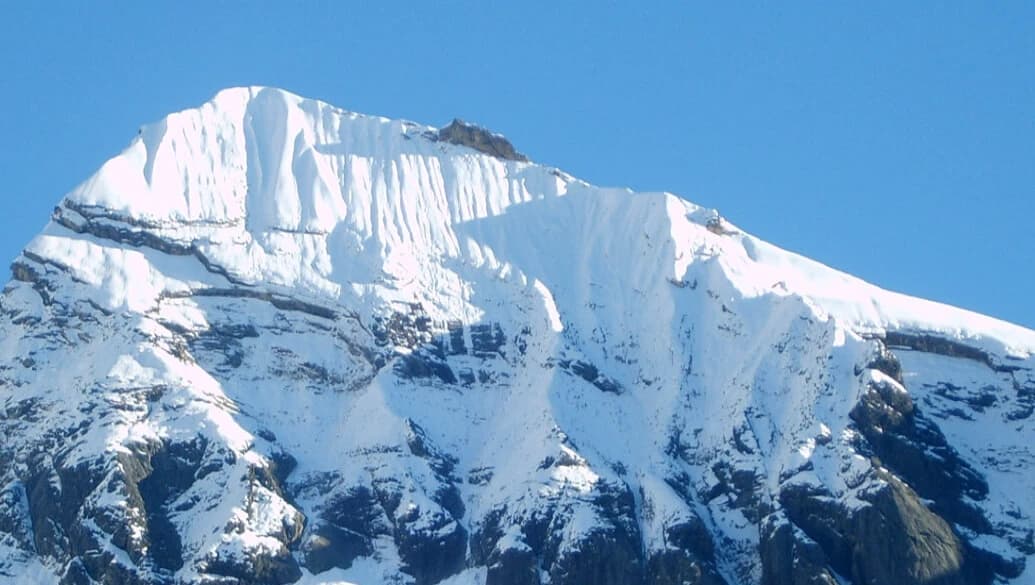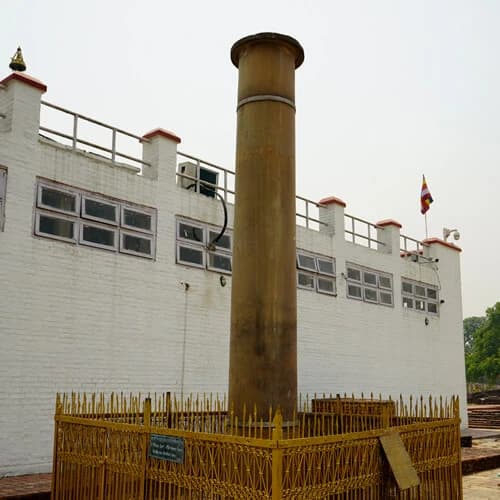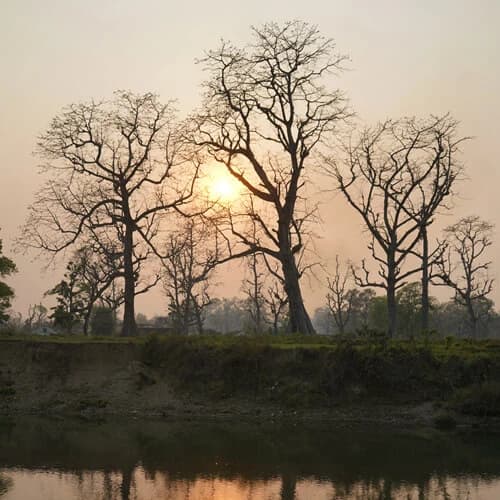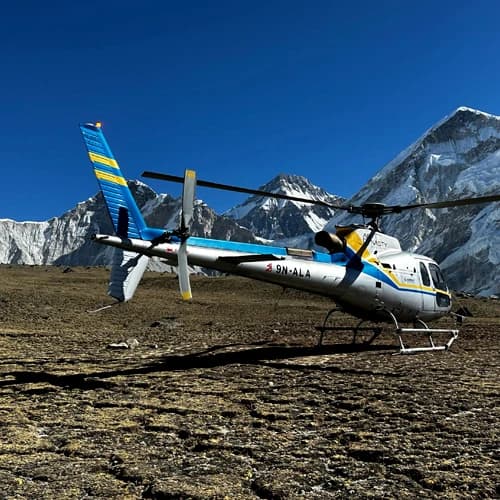Tent peak is among some of Nepal’s most famous trekking peaks. What makes the Tent Peak climbing experience so special is that you can take it as an extension of the Annapurna Base Camp (ABC) trail. Thus, you get to experience the famous ABC trail while soaring as high as 5660m. Adventure enthusiasts who want to advance from trekking to basic mountaineering should consider the 17-day Tent Peak Ascent. You also get a beautiful glimpse of the scenery and mountains in the Annapurna region on your journey.
Tent peak is locally popular as Tharpu chuli and climbing the peak can act as a stepping stone for many of your yet-to-come summit experiences! The trail to climb Tent Peak passes through Annapurna Base Camp and provides stunning views of the mountain range. The massive south face of Annapurna South (7290 meters), which is located at the start of the Annapurna South Glacier, protects the sanctuary's western flank. The route to Tent Peak Base Camp requires descending steeply into the Annapurna South Glacier while navigating a jumbled mass of loose rocks of various sizes on the glacier floor. Then, it climbs up the other side of the glacier for about 6 or 7 hours to get to Tent Peak's Base Camp, which is at roughly 4600 meters.
The Tent Peak ascent Itinerary routes meander over rocky terrain, terrace farming, rhododendron and pine forests, and local settlements. The path of the journey goes via the lovely villages of Nayapul, Tikhedunga, Ulleri, Ghorepani, Tadapani, Chhomrung, Sinuwa Danda, Bamboo, Dovan, Himalaya, Deaurali, M.B.C., Annapurna Base camp, before arriving at the final destination of Tent Peak Base Camp and Summit to Tent Peak.
The following four days will get spent climbing Tharpu Chuli from Annapurna Base Camp. We set up an intermediate camp, then the next day ascends a narrow valley to our base camp to allow for safe acclimatization. On the morning of our summit, we start early and climb fixed lines up slopes as steep as 70 degrees to the Northwest Ridge. We cross the ridge, which gradually steepens into a brief stretch with a knife-edge, and ascends to the peak. We are surrounded by the enormous Annapurna Sanctuary, a wilderness of ice and rock that is home to many peaks, including Machhapuchare, Annapurna I, Annapurna South, and Annapurna I (8,091 meters).
Your 17 days itinerary for Tent Peak Climbing begins and ends in Kathmandu. You will be met at the airport by a representative of Outfitter Nepal, who will then transport you to your accommodation. Check into your accommodation, then take a stroll through Thamel's bustling streets in the evening. You will meet your climbing guide the following day, who will give you a tour briefing. You will get to learn about the trail's condition and the difficulties that lie ahead. Your guide will also provide you with the answers to your questions. Book a departure date with us or contact us to set one as per your convenience!
Here are some things from our Tent Peak Climbing Itinerary you do not want to miss out on:
Best Features of the Tent Peak Climbing
- Visit Pokhara city and Phewa Lake.
- Sunrise from Ghorepani-Poon Hill.
- Reach the Annapurna Base Camp.
- Panoramic views for Himalayas.
- Summit the Tent Peak.
- Great views of the Himalayas from Tent Peak.
- Visit UNESCO cultural heritages sites in Kathmandu.
- Visit the Gurung villages of Chomrong.
Spend Time in Pokhara, the City of Lakes
Pokhara, Nepal's second-largest city, is on the route to Tent Peak. During the start and finish of the Tent Peak climb, you have the opportunity to spend two nights here. You have the chance to visit some popular tourist attractions. Similarly, you can boat on the serene Fewa Lake while admiring a beautiful sunset. Similar to Thamel, in Pokhara, where you can meet many other travelers at the Lakeside Market.
Explore beautiful Ghorepani village
Ghorepani is a lovely village surrounded by lovely rhododendron trees and snow-capped mountains. You will have one of the most memorable experiences of your life here among the Gurung and Magar people. In Ghorepani, you will be able to speak with them and observe how they live their daily lives.
From Lower Ghorepani, we can get vistas of mountains, but from Upper Ghorepani, we can see mountains up close. In the afternoon, clouds cover the Annapurna and Dhaulagiri mountain ranges, and the temperature lowers in the evening. The sunrise and sunset views from Poonhill are the main draw of this trek.
Witness gorgeous sunrise from Poon Hill
Poon Hill, a well-known vantage point in the Annapurna region, is situated above the village of Ghorepani. Poon Hill offers beautiful dawn and sunset views, as well as a distant perspective of the western Himalayas. Trekkers typically take a short trip up to Poon Hill.
The sunrise above the Annapurna and Dhaulagiri region peaks at Ghorepani in the early morning is the highlight of the Poon Hill Trek. If getting up early isn't your thing, you'll still be as amazed if you stay for the sunset. The view of the Annapurna range is glorious from here!
Experience the rich culture and traditions of locals
During Tent Peak adventure, you pass by numerous villages resided by people from several communities. This journey rewards you with the Gurung and Magar customs and culture of the Annapurna Himalayas. The Gurung and Magar people of this region, who practice both Hinduism and Buddhism, are particularly unique in their culture.
You may observe the excitement in this Annapurna region, especially during Dashain and Tihar, when people play deusi bhailo collectively. If there are foreign visitors, they tend to include them in their group and continue to enjoy themselves. This festival takes place in late October or early November.
Trek through Annapurna Sanctuary
The trail passes through Annapurna Sanctuary, which is a protected area. You get to see a diverse range of flora and fauna. Different types of forests, vegetation, and climate are part of this sanctuary.
An astonishing range of habitats is created by the various combinations of heights and depths. Rhododendron and bamboo cover the south-facing slopes in dense tropical rainforest, whereas the north-facing slopes, in the rain shadow, have a drier, cooler environment.
Explore Annapurna Base Camp
If you are a trekking enthusiast, you know about the infamous Annapurna Base Camp! Hundreds of travelers visit this place to see wonderful landscapes and views of snow-capped mountains. You get to see many fellow trekkers here during the peak season. Located at 4,130 meters, it is one of the most famous trekking destinations in Nepal.
Summit Tent Peak
Climbing Tent Peak is the main highlight of the journey. From ABC, you ascend to the Tent Peak Base Camp and gradually move towards the summit. During the climbing, you get full support from your Sherpa guide. He fixes the ropes for you in the required areas and helps you not only reach the top but also return safely.
Soak yourself in the natural hot spring at Jhinu Danda
After a long walking period, you descend and reach Jhinu Danda on the way. This place houses a natural hot spring, where you can spend some time relaxing your sore muscles. These natural springs are known for treating skin diseases as well. Do know that you have to pay a few extra bucks to use the service, which is not included in the Tent Peak package.
Get to see tempting scenery and panoramic views of the Annapurna Himalayas
Tent Peak Itinerary offers beautiful landscapes throughout the journey. You get to see different perspectives of snow-capped mountains. The trail is packed with lush green forests, picturesque villages, streams, suspension bridges, snowy peaks, and superb flora. Mountains like Annapurna Range (8,091 m), Mt. Dhaulagiri (8,167 m), Mt. Machhapuchhre (6,993 m), Mt. Nilgiri (7,061 m), Tukuche Peak (6,920 m), Mt. Hiunchuli (6,441 m), etc.
Tent Peak Grade
Tent Peak, also known as Tharpu peak is enlisted as a trekking peak in Nepal according to Nepal Mountaineering Association (NMA). Thus, you can ascend to the top of the peak without an extreme level of hardship like the higher altitude peaks in the Himalayas.
Tent Peak Route
Your 17 days Tent Peak Ascent Itinerary starts and ends in Kathmandu. At first, you have your scenic drive to Pokhara from Kathmandu. The next day, you have a short drive to Nayapul from where you will be trekking to Tikhedhunga. For the next consecutive days, you will be trekking to Tadapani, Chhomrong, Himalaya and finally Annapurna Base Camp. Your true Tent Peak ascent starts from here. From ABC, you trek until the Tent Peak Base Camp. The next day, you trek until the high camp. Finally, the day you were waiting for has arrived. Early in the morning, you slowly start ascending the Tent Peak. After summiting the peak, you descend to the base camp. From the ABC, you descend to Dovan, Jhinudanda and finally Nayapul within the next few days. From Nayapul, you finally drive to Pokhara and then Kathmandu. This way, you complete your Peak Climbing in 17 days!
Tent Peak Climbing Cost
Depending on the number of guests, Outfitter Nepal's 17-day Tent Peak Climbing package costs between US$ 1700 and US$ 2200. The price drops to as little as US$ 1700 for groups of 7 to 14, while it rises to about US$ 1900 for smaller groups of 2 to 6. The cost of your package is approximately US$ 2200 if you are a solo trekker. However, these are the standard costs to maintain modest hospitality during your food and accommodation. Please note that the cost of the itinerary can be altered to meet your demands. We can readily accommodate your request to extend your stay.
Seasons to Ascend the Tent Peak
Tent Peak Climb in Spring (March, April and May)
Spring is considered the best season to ascend the Tent Peak and especially trekking in the Annapurna region. In Nepal, spring lasts from March through May. In the spring, the temperature is perfect for trekking as it is neither too hot nor too cold. In the spring, the daily average temperature ranges from 61 to 68 degrees Fahrenheit or 16 to 22 degrees Celsius. During the night, the temperature may fall by up to 2 or 3 degrees Celsius or 27 or 28 degrees Fahrenheit.
In the spring, the sky is clear, allowing you to take in uninterrupted vistas of the stunning Himalayan ranges. There is a chance of rain in the spring, but it rarely lasts long.
Tent Peak in March
The weather is very different in each location along the Annapurna trail in March because of the difference in altitude. Thus, there are some variations in the Annapurna region's temperature and sunshine levels. Also, the projected amount of rainfall along the places is fairly diverse.
March is generally a dry month. It is extremely dry and chilly in the first few days of March. In comparison to earlier days of the month, the temperature is warmer now. The nighttime temperature is lower than the midday temperature. Your trek's high-altitude areas can experience temperatures as low as -15 degrees Celsius.
Tent Peak in April
It is of the best months to trek on the Annapurna Trail in April. It's neither too hot nor too cold! The sky is therefore clear. Although not as long as in the summers, the days are still pretty lengthy. You can take strolls through the settlements you visit on your walk thanks to the long days.
In the lower parts of your trek, it rains more frequently. Lower amounts of precipitation are experienced as you ascend in altitude. Ascending the Tent Peak goes without any hassle!
Tent Peak in May
In the Annapurna region, May marks the end of the spring season. The monsoon season in Nepal officially starts when this month is through. After May, the Annapurna region has quite a bit of rainfall. May's later half experiences a significant amount of rainfall as well. Thus, you have to pack your equipment accordingly for your peak climbing adventure.
Tent Peak Climb in Autumn (September, October and November)
Autumn is another best time to trek in the Himalayas, especially for Tent Peak climbing! It is the time of year when you can enjoy the exquisite natural perfumes of numerous flowers while climbing to Annapurna, and the weather is clear and precise as a result of heavy rainfall before the autumn season. Due to the temperate weather and fresh surroundings, the autumn season is regarded as one of the best times to stroll around the Annapurna trail.
Throughout the autumn season, you won't have to be concerned about persistent rain or thick clouds obstructing the breathtaking view of mountain ranges and the countryside. It is pretty pleasant to stay because the temperature at lower elevations consistently ranges between 15 and 20 degrees Celsius and does not dip below freezing at night. Similarly, the temperature may drop as you go higher, but not at an intolerable level!
Tent Peak in September
The start of the autumnal season is signalled by September. But September's first few weeks are wetter than the remainder of the month. The monsoon season finishes in August, which accounts for this. Therefore, the first few weeks of September still see some rain.
The hottest month of the autumn season is in September. As fall progresses, the amount of sunshine gradually diminishes. The wind speed is likewise at its lowest in September. This makes trekking to Annapurna in September very enjoyable for all trekkers. Tent Peak ascent is also doable because the slopes are not as muddy.
Tent Peak in October
The likelihood of precipitation decreases as you ascend. Only 6 millimetres of rain will fall at the higher altitudes in October. This statistic is about 7 times slower than the rainfall in Ghorepani or Chhomrong.In October, there will be 28 dry days and 2 days with less than 2 mm of precipitation. Additionally, there won't be any snowy days this month. The average temperature for the October trek to Annapurna hike is probably about 10 degrees making trekking conditions quite great. In October, you'll delight in the tent peak experience.
Tent Peak in November
Of all the months of the autumnal season, November is the driest. There is almost no possibility of precipitation this month. In terms of the amount of sunshine received in the Annapurna region, it is also the mildest month of autumn. However, once the winter season's impacts start to be felt around the end of November, you might feel a little chilly




